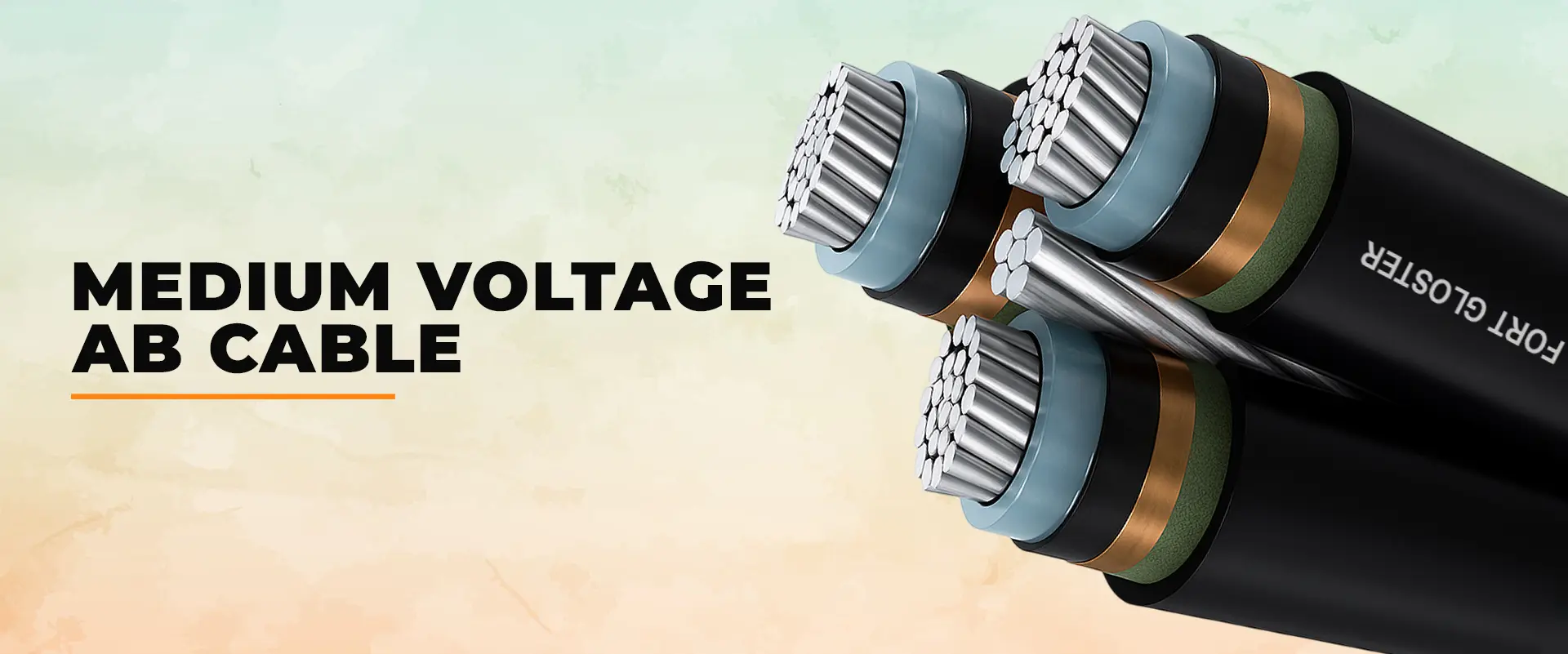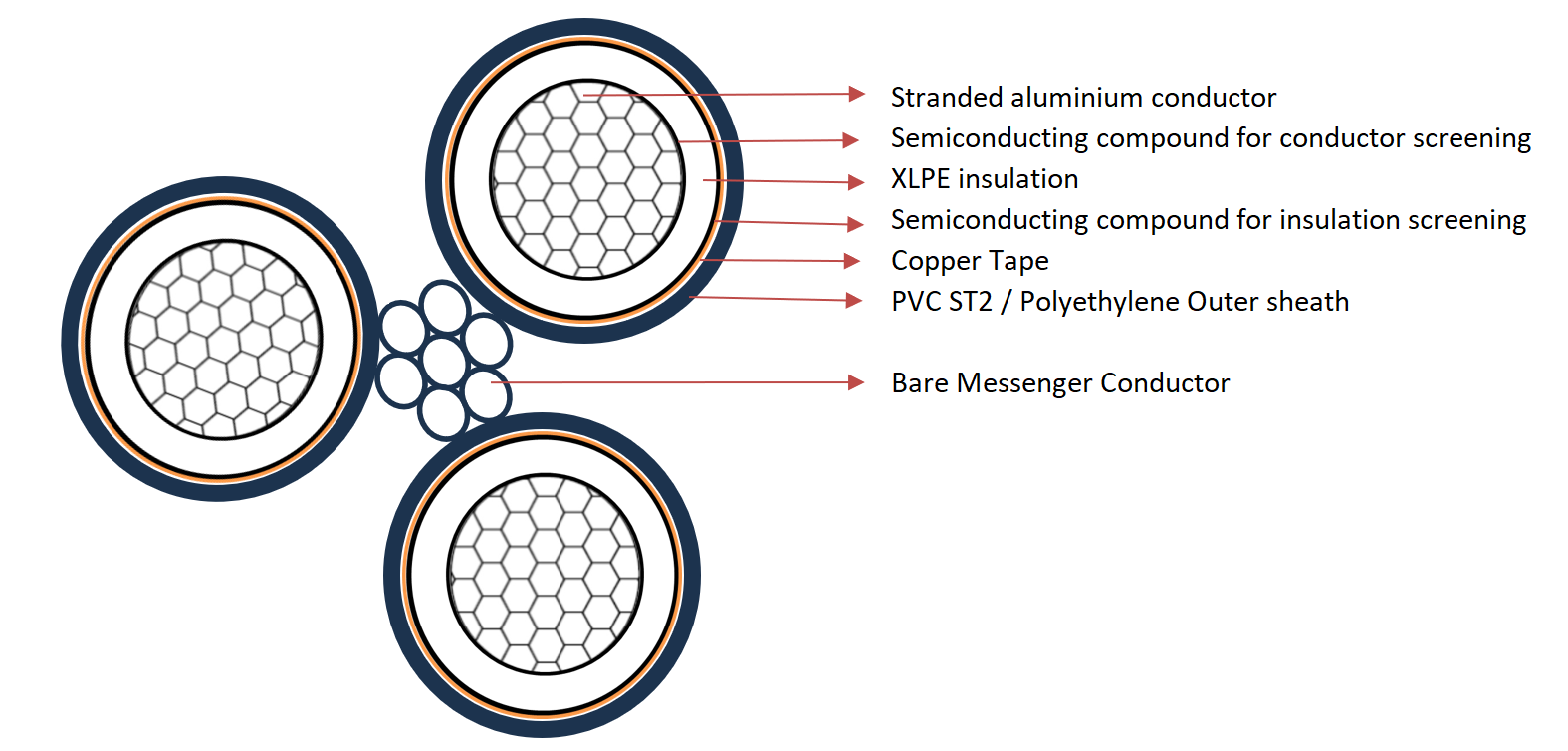
MV Aerial Bunched Cables are a compact and safe solution for the distribution of medium-voltage power (typically between 1 kV and 33 kV). These cables consist of multiple insulated conductors bundled together, offering a safe and efficient method of power distribution in both urban and rural environments.
“Reliable, Safe, and Efficient Power Distribution for Medium Voltage Networks”

MV Aerial Bunched Cables are designed to meet the needs of medium-voltage networks, offering significant advantages over traditional bare conductor systems. They are particularly suitable for high-density urban areas, industrial applications, and rural electrification projects, combining high safety standards with a more compact and aesthetically pleasing design.
Space-Efficient Design:
The compact nature of MV aerial bunched cables allows them to be installed in limited spaces, such as crowded urban areas, or on existing utility poles without requiring excessive clearance.
Enhanced Safety:
The conductors are insulated, reducing the risks of electrical shocks, short circuits, and fire hazards that are common with traditional bare conductor systems. This feature is particularly valuable for environments with a high human population density or frequent outdoor activity.
Durability::
MV aerial bunched cables are made from materials that can withstand harsh weather conditions, including rain, high winds, UV exposure, and temperature variations, ensuring long-term reliability.
High Voltage Insulation:
The cables are insulated with Cross-Linked Polyethylene (XLPE) to withstand medium-voltage levels. The insulation is designed to resist moisture, mechanical stress, and thermal expansion, making them more durable than bare conductor cables.
Aesthetic and Environmental Considerations:
With their neatly bundled design, MV aerial bunched cables are more aesthetically pleasing than traditional bare cables. This reduces the visual impact on communities and preserves the environmental landscape, especially in areas of natural beauty or urban settings.
Voltage Rating:
MV aerial bunched cables are typically used for voltages from 3.3 kV upto 33 kV (depending on the specific application and region).
Conductor Material:
Conductors are commonly made from aluminium or aluminium alloy, which provides excellent conductivity, reduced weight, and high strength.
Insulation Material:
Insulated with XLPE (Cross-Linked Polyethylene), which provides superior electrical and thermal performance.
Temperature Range:
These cables can operate in temperatures ranging from -20°C to 90°C, which makes them suitable for both hot and cold climates.
Conductor Configuration:
Typically, MV aerial bunched cables come in three-phase configurations, with an optional neutral conductor and possibly a messenger wire for structural support.
Nominal Size Range for phase conductor:
Conductor material will be aluminium as per IS 8130 and conductor size will be 35mm², 50mm², 70mm², 95mm², 120mm², 150mm², 185mm², 240mm² and 300mm² to suit different current-carrying capacities and installation needs.
Messenger Conductor:
The messenger conductor will be of aluminium alloy as per IS 398 Part 4 can be Bare as well as Insulated (As per customer requirements).
Compliance:
These cables conform to Indian standards generally as per IS 7098 Part 2 ensuring their safety, quality, and performance.
Urban Power Distribution:
Ideal for high-density urban areas where overhead power lines are required but underground cabling is not feasible due to high costs or complex installations.
Rural Electrification:
MV aerial bunched cables are widely used in rural and semi-rural areas for power distribution to agricultural areas, and other facilities, providing an economical and reliable solution.
Industrial Applications:
Used in industrial zones and large facilities for medium-voltage power supply, such as factories, power plants, or processing units.
Power Transmission and Distribution:
Suitable for medium-voltage transmission lines between substations or for distribution networks that require reliable, insulated, and space-efficient cables.
Agriculture:
Used to power irrigation systems, water pumps, and other agricultural infrastructure in remote areas, where access to underground cabling is limited.
Compact and Space-Saving:
MV aerial bunched cables require less space compared to traditional power lines, making them ideal for urban and rural areas with limited overhead space.
Safety:
The insulated conductors minimize the risk of electrical accidents, including electrocution, fire hazards, and power outages due to environmental damage.
Lower Installation Costs:
Compared to underground cables, the installation of MV aerial bunched cables is faster and less expensive, as it does not require trenching or underground work.
Aesthetic Benefits:
With their streamlined design, MV aerial bunched cables blend better into the environment than traditional bare wires, improving the visual appeal of neighbourhood’s and industrial areas.
Reduced Transmission Losses:
The high-quality conductors and compact design reduce power losses during transmission, ensuring higher energy efficiency compared to older open-wire systems.
Reduced Risk of Damage:
The bundled design reduces the likelihood of wire damage from external factors like falling branches, animals, or accidental contact, which is common with traditional open-wire systems.
Regular Inspections:
Inspect the cables for visible damage, wear, and tear, especially after storms or heavy winds. Check for any sagging, cuts, or abrasions on the insulation.
Cleaning and Upkeep:
Ensure that cables are free from debris, vegetation, or dirt that could cause short circuits or mechanical stress.
Quick and Easy Repairs:
The modular design of MV aerial bunched cables allows for fast repairs by simply replacing the damaged section or splicing the cable.
Simple Installation Process:
MV aerial bunched cables are easier to install compared to underground cabling. They are installed by mounting them on existing utility poles or newly constructed support structures.
Installation Requirements:
Ensure proper tension and clearance during installation to avoid cable damage. Clamps and insulated fittings must be used to securely attach the cable to support structures.
| Cable Size
(Sq.mm) |
Max DC resistance of phase conductor at 20 deg C
(Ohm/Km) |
Current Rating in air at 40 deg C (Amps) | ||
| 1.9/3.3 KV to 3.8/6.6 KV | 6.6/6.6 KV to 11/11 KV | 12.7/22 KV to 19/33 KV | ||
| 3C X 35 | 0.868 | 139 | 140 | 144 |
| 3C X 50 | 0.641 | 166 | 167 | 177 |
| 3C X 70 | 0.443 | 208 | 209 | 220 |
| 3C X 95 | 0.32 | 252 | 254 | 264 |
| 3C X 120 | 0.253 | 292 | 294 | 303 |
| 3C X 150 | 0.206 | 329 | 331 | 340 |
| 3C X 185 | 0.164 | 380 | 383 | 387 |
| 3C X 240 | 0.125 | 448 | 450 | 449 |
| 3C X 300 | 0.100 | 511 | 512 | 501 |
Fort Gloster Industries Limited policy of continuous improvement may result in a change in specifications without prior notice. Any warranty of any nature relating to any Fort Gloster product is only contained in the written agreement between Fort Gloster Industries Limited and the direct purchaser of such product(s).